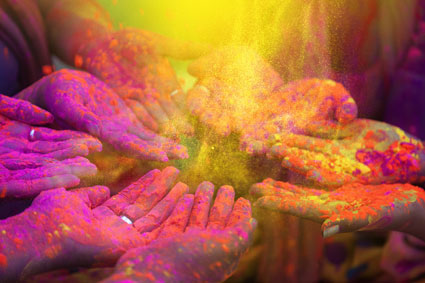People have been classifying and discussing emotions since the beginning of humankind. The definitions of emotions presented here are one researcher's classifications.
In this discussion, I specifically avoid classifying emotions as "good" or "bad," or "positive" and "negative." This is because emotions simply are. If we call an emotion bad or negative, we get the impression that experiencing this emotion is somehow bad or negative. All emotions are normal and natural. All are important and play their role in our lives. Some are more pleasant than others, for certain. But that doesn't mean that some should be avoided, or that we should seek to suppress any, for doing so might have adverse effects on our mental, emotional, and even physical well-being.
That said, it is important to appropriately manage our emotional expressions. No doubt, inappropriate emotional expressions can wreak havoc and cause significant damage to our relationships. What are defined as appropriate emotional expressions varies cross-culturally, as it is, to some extent, culturally defined. In this article, we will discuss the range of natural and normal human emotions, followed by a discussion of emotional intelligence.
Emotions definitions
Researchers have defined emotion as "the body's multidimensional response to any event that enhances or inhibits one's goals." For example, your nervousness before the first date has to do with possible goal interference. The possibility of the date going poorly interferes with your desire to have a good time and make a new connection, possibly for a lifetime partnership. If the date goes poorly, your goal of making a new connection and finding a life partner is inhibited. If your partner is showing interest in a third-party, you feel jealous, because your exclusive relationship with your partner is being threatened.
Essentially, all human emotions fall into one of three categories: joyful/affectionate, hostile, and sad. Joyful/affectionate emotions include happiness, love, passion, and liking. Happiness is the most universally recognized of all human emotions. It is a condition of contentment, pleasure, and good cheer. In all cultures, people express happiness by smiling, laughing, and being energetic, and these characteristics are also interpreted as happiness. When we feel happy, we tend to want to share with others by approaching them, and reconnecting with them. When this occurs, it often makes the other person happy as well, resulting in happiness as a truly social experience. Research indicates that being happy reduces our stress, thus contributing to overall health and well-being.
There are many kinds of love. Essentially, it is caring for, feeling attached to, and feeling committed to someone. We experience romantic love, love for friends, love for family members, love for God, and love for self. Love is a remarkably powerful emotion, and can cause people to do things they would not otherwise do � such as leave their lives behind and move around the world. Love is sometimes accompanied by passion, which consists of joy and surprise, coupled with experiences of excitement and attraction. Because passion is partially fueled by novelty and surprise, it often marks the early stages of a relationship, yet begins to fade as the relationship extends over time.
Liking is the positive evaluation of another person. You probably like someone if you enjoy spending time around him or her and view that person's behavior positively. Liking is different from love, in that liking is the positive evaluation of someone, while love is a sense of commitment to that person. Therefore, it is entirely possible to like someone without loving them, and to love someone without necessarily liking them. Displays of liking tend to include behaviors such as smiling, touch, and close proximity to the person. We also tend to share activities with people we like, and make an extra effort to spend time with them because we enjoy their company. Liking, love, and passion are all distinct emotions, but each motivates us to spend time in the company of others. Happiness drives us to interact with people we like and love. In this way, these joyful/affectionate emotions draw us to people we care about, thus enhancing our interpersonal communication.
The hostile emotions are anger, contempt, disgust, jealousy, and envy. It is especially important to manage these emotions appropriately, as they can destroy our relationships. Anger is the emotion we feel when we perceive we have been wronged. When we feel that someone has wronged us, we might yell, throw things, make unpleasant facial expressions, or even physically attack that person. Although anger is a natural and normal emotion, several studies have shown that it can be harmful to our health, as the stress of feeling and expressing anger can elevate the risk for a variety of serious health problems. Research further indicates that people with an inability to control their anger have weakened immune systems and heal more slowly from wounds, when compared with those who manage their anger more positively. Contempt leads someone to feel they are better than someone else. Naturally, this can have very adverse effects on personal relationships. Expressions of contempt include insulting or mocking others, putting people down, belittling or making fun of people, and suggesting that the other person is stupid or incompetent. Actions such as these sand messages of judgment, disapproval, and disrespect, which research suggests can trigger a cycle of negativity within relationships. Psychologist John Gottman has found that expressions of contempt by one partner lead the other to withdraw and become distant, often leaving conflict unresolved and risking a breakup of the couple.
The emotion of disgust occurs when you have a feeling of revulsion in reaction to something offensive. This can be a foul odor, or a message or image that you find profoundly offensive. Disgust motivates you to avoid, reject, or expel the source of your disgust. People can feel disgust for those whose values, beliefs, or behaviors they abhor, which leads them to avoid people, and even artifacts, they feel represent those individuals.
Jealousy and envy are often used interchangeably, but this is an error. In fact, we feel jealousy when we perceive that the existence or quality of an important relationship is being threatened by a third party. Envy, on the other hand, is a desire for something another person has. Jealousy is quite complex; it is actually a mixture of three emotions: fear (of losing a relationship), anger (at the individual threatening it), and sadness (at the prospect of losing the relationship). Jealousy is not limited to romantic partnerships, but can occur in any type of important relationship. Envy, the desire for something someone else has, only occurs when that something is important to us. For example, you will only envy someone's designer wardrobe, if you want one for yourself. Envy can be a great motivator for self-improvement. For example, if you envy your sister's high-quality education, you might be motivated to go back to school.
Hostile emotions, like joyful/affectionate emotions, influence the way we interact with others. Unlike joyful/affectionate emotions, however, hostile emotions are often challenging for relationships and unpleasant to experience. What is important is not to suppress these emotions, but rather to learn constructive ways of managing them.
Sad/anxious emotions can be just as unpleasant as hostile emotions, but they prompt us to withdraw, instead of attack. As a result, they can be just as damaging to our interpersonal relationships. Sad/anxious emotions include sadness, depression, grief, fear, and social anxiety. Sadness involves feeling unhappy, sorrowful, and discouraged, usually resulting from some form of loss. Indeed, the loss of a person, and the termination of the relationship, are two of the most common causes of sadness. Loss of a person can mean loss to death but it can also mean loss to a mental illness, or moving far away. Expressions of sadness don't vary much cross-culturally, and tend to include frowning, crying, disengaging from normal activities, and speaking quietly, slowly, and without energy. While sadness is a normal emotional response to loss, depression is a physical illness. It involves excessive fatigue, insomnia, weight changes, feelings of worthlessness, and suicidal thoughts. Clinical depression is profoundly debilitating, and can lead to job loss, divorce, social isolation, and strained friend and family relationships. Treating depression can include various antidepressant medications, and various forms of counseling and psychotherapy. Engaging in physical exercise and journaling has also been shown to help alleviate depression. The experience of profound sadness in response to a loss is known as grief. Researchers suggest that grief is less an emotional experience, than an emotional process of dealing with a grave loss.
When we perceive danger, our minds and bodies react with fear. When we perceive danger and experience fear, certain responses in our brains are triggered. Include increased heart rate and breathing rate, pupil dilation, and elevated stress hormones. These physiological changes make us aware of the potential danger and give us extra energy to respond to it. The purpose of fear is to keep us safe from harm. Our responses are typically to withdraw from the situation and protect ourselves, at least long enough to assess the situation and figure out a way to best deal with it.
When we fear not making a good impression on others, we experience social anxiety. Whether you are meeting your girlfriend's parents for the first time, giving a public address to your class, or starting your first day in a new job, you want to make a good impression. The fear of not doing so produces social anxiety. It is normal to feel socially anxious from time to time, but when this anxiety becomes chronic, or begins to interfere with quality of life, normal social anxiety may have moved into the classification of mental illness known as social anxiety disorder. This condition generally requires some combination of psychotherapy and medication to treat.
Experiencing these sad/anxious emotions often makes us want to withdraw from social interaction. Sometimes we need time alone to deal with our emotion or, in the case of fear or social anxiety, to feel protected and safe. When we suspect that someone is experiencing a sad or anxious emotion, our tendency is to want to go to them to help soothe them. It's important to remember, however, that they may need some time alone.
One interesting characteristic of emotions is that they are contagious. Emotional contagion is the tendency to mimic others' experiences and expressions. If you have ever been in a group of people that's generally content, then someone joins who is very sad, you know that it isn't long until everyone is a bit sad, as well. The same is true of a so-so mood of a group, or perhaps of yourself, and someone who is very happy joins you. It isn't long until your spirits are lifted.
Emotional intelligence
We can facilitate emotional intelligence through the use of simple openers. For example, when others want to process their emotions, instead of saying, "Oh that's too bad," or "You're overreacting," we can use questions to help the appraisal process. These might include, "Why do you think you got so angry?" Or, "Why do you think you love her?" When you feel the need for emotional expression, ask yourself what you hope to accomplish. If you really just need to vent frustration, verbalize that need. But if you are trying to understand the complicated emotion, say so. An example might be, "I'm so confused; can I talk to you about something?" Verbalizing your needs with your emotional expression will help your listener understand your purpose and know how to more appropriately respond to you.
The expression of emotions can either help our relationships become more healthy and satisfying, as in when we practice emotional intelligence, or can potentially destroy our relationships, such as when expressions of anger are not appropriately managed or controlled. There are many benefits to practicing emotional intelligence. It is essentially a matter of being conscious and aware, and being willing to process and identify your emotions in an effort to express them appropriately for the situation.
























